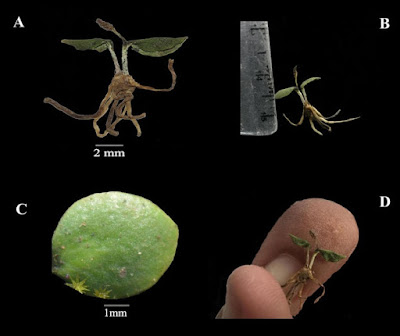 |
| Ophioglossum malviae Mitesh Patel & Mandadi Narsimha Reddy
in Patel & Reddy, 2018.
|
Ophioglossum L. commonly known as “adder’s tongue fern”, has been of great interest due to the highest number of chromosomes in any organism so far known in biological world. Here, a new species of adder’s tongue fern has been discovered and reported from Western Ghats of India. It is prominently distinct from the other known taxa in Ophioglossaceae family. Phylogenetic analysis of three chloroplast DNA (cpDNA) regions (trnL-F, rbcL and psbA-trnH) unambiguously designate this adder’s tongue fern as the distinct lineage and is sister to the clade containing O. parvifolium and O. nudicaule. Azolla caroliniana – an aquatic fern (average size, 0.5–1.5 cm), is the smallest fern on the earth. Our discovery discloses a new species of adder’s tongue fern and ranking it among the smallest terrestrial fern in the world, attaining an average size of only 1–1.2 cm.
....
 |
| Figure 1 Ophioglossum malviae sp. nov. (A,B and D) Entire plant (C). Tropophyll size, shape and venation. |
Taxonomy
Ophioglossum malviae
Mitesh Patel & Mandadi Narsimha Reddy sp. nov.
Diagnosis: O. malviae sp. nov. is unique among species of this genus by its very small size and spike, spores with outer perine layer and unique type of stomata in which the marginal cells of lower epidermis form dome like papillae.
Type locality: Jakhana village (altitude ~471 m), Dang district, Gujarat, Western Ghats, India.
Etymology: This species is named after a lady Malvi Surti who inspire the first author for pursuing research in this field.
Distribution and ecology: India – Gujarat state, Dang district, Jakhana village. The species grows in grassy area along with mosses on the grasslands of Jakhana village at an altitude of ~471 m, located in Ahwa forest division.
Conservation status: Currently, about 12 plants of O. malviae sp. nov. were found in the type locality. However, this area is poorly explored for the Pteridophytes diversity. Therefore, an assumption that the other population might be distributed around this area and more further explorations are needed to determine its full range distribution, the species should be considered as data deficient for now.
Mitesh Patel and Mandadi Narsimha Reddy. 2018. Discovery of the World’s Smallest Terrestrial Pteridophyte. Scientific Reports. 8, Article number: 5911. DOI: 10.1038/s41598-018-24135-2

